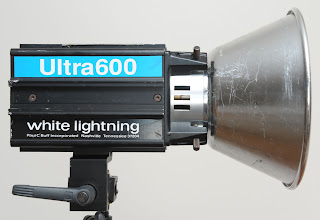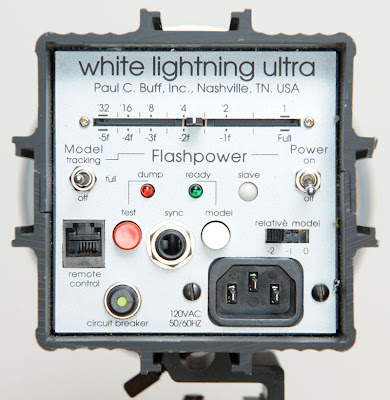 Speedlights are great, and I use them about 90% of the time. But that does not mean they are always the most appropriate tool for the job. Nor does it mean they might be the best choice for your style of lighting.
Speedlights are great, and I use them about 90% of the time. But that does not mean they are always the most appropriate tool for the job. Nor does it mean they might be the best choice for your style of lighting.If you have learned to use your speedlights in manual, you should not at all be intimidated by the idea of using "studio strobes." In fact, you'll probably find the typical monobloc to be very familiar territory by now.
__________
Lose the Dogma
First of all, any time I shoot something with a monobloc, someone comments about it "not being Strobist," as if we had some kind of kosher standard going on around here. For Pete's sake, Strobist is the name of a website. I know, because I made it up in 2006. And there was no burning bush or stone tablets involved at all.
I used speedlights most of the time as a PJ, because they are the flashes I always had with me. And I created L101 and L102 around speedlights. But that is because speedlights are small, portable and the most accessible way for people to learn about lighting.
Most people learn to shoot with a little .22-calibre rifle, and save the .50 cal until a little later when they need to pierce an engine block at 700 yards.
IMO, to extend the speedlight ethic into a frame of mind where monoblocs (or pack and head systems) are somehow not to be considered is just silly. I am an available light photographer. Meaning, if a light is available I will consider using it.
Speedlight, monobloc, car headlight, iPhone -- I have used them all. If I think an ignited fart will improve a photo, then please pass the beans and matches. Speedlights are wonderful little lighting machines. But they are not the end-all, and they are not always necessarily the best tool for any given job.
There. Just wanted to be clear on that.
And I am kidding about the beans. Don't try that for a light source. At least, we don't to that in my family anymore. Not since that emergency room visit for my uncle Morris. (And I am not kidding about that, either.)
Been There, Done That
For lighting large objects (or overpowering sun at a reasonable working distance) bigger flashes simply make more sense than speedlights. My "big" flashes are two old White Lightning Ultra 600's. They are very similar to the current WL models and to today's AlienBees, except my 600's have had the crap beaten out of them.
I am currently re-evaluating my monoblocs and deciding which direction I want to go with them in the future. But I wanted to use the opportunity to take a moment and do a walk-thru for those of you who are unfamiliar with bigger flashes.
Today, we will walk through a typical control panel, much of which will be familiar to manual speedlight users.
__________

(Click the pic for bigger in a new window.)
Here is the control end of a WL Ultra 600, which is a 300 watt-second (WS) monobloc. It is typical in layout to most other mono's, and this one is about five times more powerful than your average speedlight.
Up top, you'll see the power level adjustment. This is exactly like dialing down your manual power level in a speedlight, except in this case you are not limited to full- (or half-, or third-) stop increments. This is a continuously variable, minus 5-stop power control, and one of the reasons I love the White Lightnings and AlienBees.
Actually, power level is an area where many speedlights and monoblocs intersect, too. For example, this a 300WS monoblock. If I dial it down a stop, it is now at 150WS. Down two stops is 75WS, which is getting into the neighborhood of an 60WS SB-800. So, they cross over in power output for the range of -3, -4 and -5 stops on the monobloc.
The efficiency of the reflector in the WL gives a little more light output per watt-second. But you will still find an area of crossover between the two. This is convenient, as it means you can use both types of flashes in conjunction if you only have one monobloc and a few SB's.
On the left is the modeling light switch, which will be of less importance to you if you have grown up using speedlights. They are nice to have, but also introduce some significant limitations when you try to power the mono's with batteries. More on that later.
Across the middle you'll see buttons, jacks and lights. The red "test" button is exactly the same thing as the test button on your speedlight. You push it and the flash pops.
Just above the test button is a "dump" light. This is an indication that the flash is storing too much power because you charged it up and then lowered the power level without popping the flash to bleed the unneeded juice. Most new mono's dump this power automatically. (They call it "auto dump.") But if yours does not this, is a good thing to know. If that light glows, pop the flash, Simple as that.
That round hole is the sync jack. What is a coveted but much-missing feature on many speedlights is standard equipment on a monobloc. Which is good, as you cannot very well mount a mono on your hot shoe. Pay attention to the type of connection for this jack, when shopping for a big flash. It can either lock you into proprietary connectors or free you to use standard, cheaper cords. My preference is 1/8" or 1/4" audio-jack-type connectors.
The white "model" button at center right actually helps you to know your flash is ready by turning off the modeling lamp until the flash is fully recycled. Some flashes can be set to emit beeps when recharged. A model-off-when-charging setting just gives you a visual confirmation.
The white dome further right is the optical slave receptor. Slaves on mono's are typically pretty sensitive, but you cannot aim them well because they are always gonna point away from the direction that particular mono is firing.
Speedlight slaves typically can be rotated to different directions from the flash head, which helps a lot. This is partially offset be the fact that the mono's will typically be firing more powerful light, so slaves can usually see the pulse better.
At far right you have the power switch -- simple enough. Just below that is a proportional model switch, which can get you an apples-to-apples modeling light comparison with WL monoblocs of different power settings.
Round that out with a circuit breaker (bottom left) and a remote control jack (far left). The latter allows the power and sync of a flash to be controlled by a wired remote.
If it looks complicated, it is not. At it's heart, it is a big, manual flash with a slider power control, a sync jack and a built-in slave. You already understand all of the important stuff.
And that's really all you need to know to handle most monoblocs just fine. They mount to your stands and light mods just like speedlights, as they have built-in umbrella swivels. And all of the theory and practice is the same -- you just have more power to play with.
You'd think the fancy control panels would be where the most important differences lie. But really, it is the lighting flexibility (and power) at the business end that mostly separates these guys from the little flashes.
More on that, in part two.


























